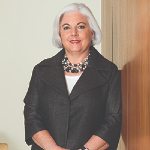An Interview with Andrea Petro, Board Member of Ready Capital Corporation and Consultant to Waterfall Asset Management
November 15, 2021
By Charlie Perer

In this installment of our series of executive interviews, Charlie Perer sits with Andrea Petro to talk about her new role as Board Member at Ready Capital, and to share her advice to ABL managers about consolidation, competition and the current state of the market.
Charlie Perer: What are you up to these days? Specifically, tell us about your role as a consultant to Waterfall Asset Management and Board Member at Ready Capital.
Petro: I’m a board member at Ready Capital Corporation and a consultant to Waterfall Asset Management, advising on the underwriting and portfolio management of asset-based loans. Ready Capital is one of the largest non-bank SBA lenders in 7(a) loans and the company originated over $2 billion in PPP loans during the pandemic.
The value-add to ABLs is enormous given most asset-based lenders are interested only in working capital loans for which assets turn quickly. Ready Capital focuses on owner-occupied real estate & M&E and provides term loans for significantly lower cost than non-bank real estate loans. Lower monthly payments are spread over the amortization period of the loan. That provides borrowers of asset-based lenders with more liquidity and cash flow.
Charlie Perer: Where are we in this latest market cycle?
Andrea Petro: My view is that we don’t really have a market cycle any longer. A relatively predictable market cycle had existed post-World War II through the Great Recession. But since then, the U.S. has changed significantly, from an industrial-driven to a technology-driven economy, while the federal government has used significant liquidity to bail out the economy—twice. Those types of changes make it difficult to interpret where we are in the cycle or where we are headed.
We had been in a stagnant period from 2010 until 2017, but that’s changed significantly. I think we are living in an economic and political period that I would describe as chaotic. We really don’t know whether our political parties will be able to work together and help us return to a high-growth, enabling economy. We want to see stable growth, increasing labor force participation, and declining inflation, but a positive outcome depends on an exponentially larger number of inputs that drive the economy.
Perer: Do you see any parallels to 20 years ago when the nation’s largest banks decided to be the consolidators of the largest independent ABLs?
Petro: I don’t see many parallels at all with the markets of 20 years ago. Capital markets are much more efficient today. And non-banks have much greater access to those markets and to liquidity. The economy has changed dramatically as a result of technology.
Compliance and bank underwriting standards have become significantly more demanding than they were 20 years ago. In this environment, I don’t see the value of banks acquiring large-ticket independent ABLs.
On the other hand, if the federal government does not have the ability to bail out lenders in the next downturn, then yes, there could be an increase in opportunistic acquisitions. But I think that’s a big “if”.
Perer: You have advised CEOs in commercial finance throughout the years. What are you counseling them on right now?
Petro: We are witnessing a sea change in terms of competition. Since ABL started in the 1970s, right through the pandemic, independent asset-based lenders and factors have relied on relationships to build their businesses. But what’s changed recently is the way those relationships are launched and serviced. I believe that COVID-19 has diminished the personal relationship building and relationship maintenance. Now, these businesses rely on digital marketing. Winning transactions and building a portfolio rely more on the terms of a deal and the pricing. For independents who find themselves being pursued as an acquisition target, I suggest they consider their cost of funds going forward and the multiples being offered for their businesses.
Perer: Will consolidation be focused on any part of the market such as the small-ticket ABL groups?
Petro: Banks, which dominate the ABL industry, have access to significantly more information technology, marketing programs, and financial software, all of which results in lower operating costs. Currently we are witnessing a large number of bank mergers, but loan demand is tepid and net margins are the lowest in history. The most obvious growth strategy for community and regional banks in this environment is to scale up by acquiring small-ticket ABLs and factors.
Perer: Where does the large-ticket non-bank ABL world go from here? Large pools of capital have been raised by many and these firms are becoming capital efficient.
Petro: There will certainly continue to be competition between ABLs and banks on the small portion of the market that overlaps, in terms of credit risks; the highest-risk borrowers at a bank and the lowest-risk borrowers at an ABL typically overlap; that’s where the competition takes place. Yet, lending opportunities for ABLs will persist in markets that are not entirely embraced by banks, such as direct-to-consumer retail where there is no brick-and-mortar.
Perer: What can history teach us about how to navigate a very unique time and market for ABL with many groups still significantly down from their pre-COVID asset levels?
Petro: To any independent asset-based lender, I would suggest that now is the time to review your goals. Where are you in your forecasted business plan? What are your ultimate goals and how do you plan to reach those goals? This environment presents an opportunity to review the pros and cons of selling to a larger entity. Many aspects of this business will continue to be difficult with net lending margins at the lowest levels in history. Unless your ABL business can make up for the low margins with scale or lower costs, it will be very difficult to compete. And I think this period could last many years. My advice: take a hard look at your business. Do you want to continue? And if you do, what outcome might you realistically expect at the end?
Perer: What advice would you give to a team thinking about starting a new ABL group in this market?
Petro: My first response? Don’t do it.
To expand on that, I would say that this is not a time to start. It’s never been more competitive. Net interest margins for ABLs are extremely tight even as load demand is tepid. Whether or not the environment becomes more supportive for ABL startups depends largely on monetary and fiscal policies over the next several years.
Perer: How are you helping Ready Capital educate the ABL market about ways to meet the needs of a greater range of borrowers?
Petro: Asset-based lenders have been welcoming the Ready Capital team to discuss how our 7(a) lending capability is able to support the ABL business. Forward-thinking ABLs understand that to remain competitive in their market, they need to serve clients with a more differentiated offering. For many of our partners, that differentiator can be the addition of a term loan option. An additional benefit of partnering with Ready Capital is that there is no competition for cross-sell products such as depository assets since Ready Capital is not a bank.
Perer: What is your take on the lender finance community? Has it proliferated similar to the ABL world where there are now many banks and non-banks like Waterfall that play a role?
Petro: The lender finance community has multiplied significantly over last 20 years. It’s also beginning to change. Similar to the general ABL world, relationships had at one time dominated the space because working capital lines were the lifeblood of independent asset-based lenders. Those lines are essentially their inventory and they have to trust whoever is providing their liquidity, especially when it was a very small world. At one time, there were only two or three banks competing for that business.
Now because it has become an accepted product, there has never been greater availability of credit. The product is equally dominated by the best terms and market pricing as important considerations as well as the trust-based relationships.
Perer: How is the ABL industry going to be reshaped over the next decade?
Petro: Two of the biggest trends right now have been driven by the application of technology in response to the pandemic. First, I expect that many businesses will continue to support a work-from-home or hybrid operation with diminished in-office requirements for employees. I think that is going to shape the ABL industry internally. Second, I expect there will continue to be significantly diminished levels of business travel and entertainment. Both of those are important to the bottom line. Reviewing the income statement for almost any financial institution reveals that the largest expense after staffing is occupancy. If a business can eliminate occupancy expenses through a work-from-home hybrid model, they have a competitive advantage. Similarly, travel and entertainment is typically the next largest expense category. Elimination of some of those costs by going virtual will have an impact.
It’s very likely the industry will be reshaped because the number of smaller, independent asset-based lenders will shrink. The industry will continue to gravitate towards larger portfolios, economies of scale, resulting in access to lower cost funding.
Perer: Lastly, tell us something you are worried about that the rest of the market has yet to figure out.
Petro: It’s not often discussed as a market risk, but I think cyber warfare presents a larger business risk than people realize. A widespread cyber-attack that shuts down everyday financial transactions—preventing Americans from purchasing groceries and gasoline—would shut down the U.S. economy leading to chaos and deep economic depression. I suspect cyber-attacks and ransomware events are increasing, although complete information is not made available to the general public. Everyone is aware of this risk, even though it’s rarely cited among the top risks that could create a severe crisis for the market. But it’s not a “black swan” event because we are already aware of the threat. It’s probably a higher risk than most people realize.
Andrea Petro is a consultant to Waterfall Asset Management, LLC and a member of the Board of Ready Capital Corporation, a publicly traded REIT on the NYSE, which is externally managed by Waterfall. Andrea also serves on the Board of BlackRock TCP Capital Corporation, a publicly traded BDC on NASDAQ.
Andrea began lending to specialty finance companies in 1992 and in 2000 established the Lender Finance Division of Wells Fargo Capital Finance which she led for 17 years. She joined Waterfall as a Managing Director in 2018 where she led the Specialty Commercial Finance Group.
She is a past President of the Secured Finance Network and a member of the Secured Finance Network Board of Directors and Secured Finance Foundation Board. Andrea is also a member of the Master of Science Program Advisory Council at the McCombs School of Business at the University of Texas at Austin.
Andrea graduated magna cum laude with a Bachelor of Arts degree from Kent State University and received a Master of Business Administration degree from the University of Texas at Austin.


.jpg?sfvrsn=f1093d2a_0)